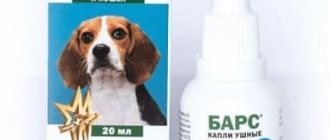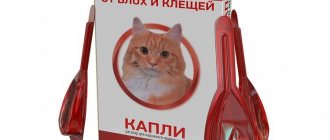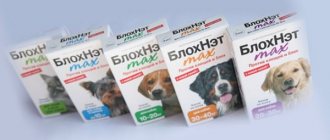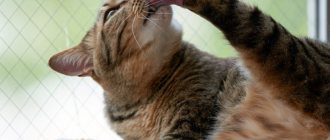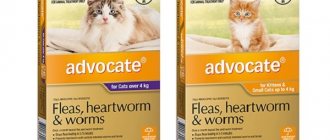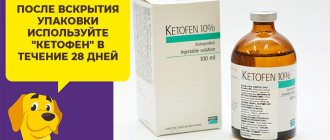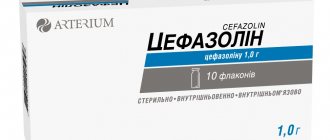Types of insectoacaricidal drops Bars and their differences
This is a product for external use with an oily consistency and a yellowish color. Fights fleas, scabies and ticks, lice and lice and protects the animal from their attacks. Available in doses of 0.5 and 1.0 ml in plastic dropper pipettes, packaged in 1–4 servings.
If your cat is itching and acting restless, it means she has fleas.
The advantage of drops over other forms is their ease of use - for a lasting result, it is enough to treat your pet’s skin once. Drops are available in three varieties:
Leopard for cats
Active components: fipronil (10 mg/ml), diflubenzuron (1 mg/ml) and dicarboximide (MGK-264) (1 mg/ml), as well as excipients. The synergistic properties of dicarboximide make it possible to achieve high efficiency and safety with a low concentration of active substances.
Bars drops are suitable for killing insects and preventing their attacks
Suitable for cats older than eight weeks. Different volumes of pipettes help to select the dose depending on the weight of the animal.
Bars Forte for cats
The composition includes fipronil, diflubenzuron and additional components, including zintorella essential oil. This is a repellent whose smell repels insects, including flying ones. It has a lower fipronil content - 0.5 mg/ml.
Bars Forte drops for cats contain less active substance
Available in 1 ml pipettes, the package contains 3 pieces. The individual dose is calculated based on the cat’s weight; 0.1 mg of the drug is required per 1 kg. Used from 10 weeks of age.
Bars Forte for kittens
A product with the same composition, but has a smaller volume of pipettes, which allows you to treat a kitten of small weight. Suitable for babies aged from two to ten weeks. One package contains 3 pipettes of 0.5 ml.
Pipettes for kittens contain only 0.5 ml of the drug
Composition and action of drops
Bars drops for cats are commercially available in the form of a clear or yellowish solution for external use, which has an odor and an oily consistency. One package contains 3 or 4 dropper pipettes made of polymer material with a volume of 1 or 1.4 ml, as well as instructions for use of the drug.
Normally, medications for cats should not contain the pyrethroid permethrin, since this substance is only applicable to dogs. Cat insecticides contain the pyrethroid etofenprox or another active substance.
The drug Bars contains 10 mg/ml fipronil as the main active substance, 1 mg/ml dicarboximide and diflubenzuron. Excipients: 50 mg/ml isopropyl alcohol, 30 mg/ml each of Tween-80 and polyvinylpyrrolidone, as well as up to 1 ml of nolyethylene glycol 400.
How do people typically think about flea and tick control products? To spray or smear your pet, then wash it and place it next to you. And the fleas drop dead at the same moment or run away in panic. But this can most likely only be seen in advertising. In reality this does not happen.
What is fipronil? This is the name of a product that can kill parasites with one blow. And therefore this substance was introduced into operation in order to destroy the central nervous system of the insect (paralyze it) before it dies after 8 hours. Moreover, it is harmless to the central nervous system of animals.
Fipronil blocks GABA-dependent receptors of ectoparasites, creating a disruption in nerve impulses, first leading to paralysis of these same ectoparasites, and then to their death.
But still, fipronil, according to the Russian catalog of agrochemicals and pesticides, belongs to the class of substances that are moderately dangerous to the human body if ingested. So if you suddenly get drops into your cat’s mouth while treating your cat, consult a doctor immediately!
Dicarboximide is a synergist that can make insecticides more active and stop the detoxification of the insecticide, making it more toxic to the parasite.
Diflubenzuron inhibits the synthesis of chitin in parasites, interferes with the molting process, disrupting it, and also disrupts oviposition and hatching of larvae from eggs, and thus the replenishment of the population stops.
The main active ingredients in Bars drops, after applying them to the skin, are distributed evenly over the surface of the body, but are not absorbed into the systemic bloodstream, but accumulate in the epidermis, sebaceous glands and hair follicles of the cat, providing an insectoacaricidal contact effect, as well as providing protection for the pet from ticks and fleas.
The principle of operation of drops and the degree of danger
Main active ingredients: fipronil, diflubenzuron, dicarboximide and cintorella oil. Each of them has its own mechanism of action:
- Fipronil is a pesticide that works as a paralytic poison, disrupting the transmission of nerve impulses. This leads to paralysis and death of adult insects.
- Diflubenzuron is also a pesticide. Blocks the formation of chitin in arthropods, in which the growth process occurs during its synthesis. Due to this, the exit of the larva from the egg is blocked.
- Dicarboximide acts as a synergist that inhibits the development of enzymes in insects that neutralize poison in the body. As a result, the pesticide properties of other active substances are increased.
- Cintorella oil repels insects and prevents their attacks.
Insecticides are not absorbed into the blood, but are distributed over the skin. They linger in the dermis, hair follicles and sebaceous glands, providing the pet with long-term protection from parasites.
Drops are intended for one-time treatment for medicinal purposes. This means that a single application is usually sufficient to completely get rid of insects.
All active substances have a prolonged effect, which makes it possible to use drops to prevent insect infestation and protect against relapse after treatment. Protective properties last for 2 months against fleas and 1 month against ticks.
Video: how to properly apply insectoacaricidal drops
The composition is classified as moderately hazardous to the body. If you follow the instructions for use, they do not have a negative effect on warm-blooded animals, but if the liquid gets into the eyes, irritation of the mucous membrane is possible. The drug is dangerous for rabbits, fish and aquatic organisms. Take into account the individual intolerance of components to animals.
Rules of application
Drops are usually supplied in a convenient form - in pipettes. In each of them, the amount of product is calculated for one application, or two pipettes may be needed to treat one dog or cat. It all depends on the weight of the pet. Despite the fact that each type of drug is accompanied by its own instructions for use, there are general rules for their use:
- do not bathe your pet two to three days before and after applying the drops,
- Apply the product to the animal’s withers (closer to the base of its skull).
- Do not comb your cat or dog for three days after treatment.
- Do not allow your pet to lick the area where the drops were applied, or for other animals to do this.
- do not allow the product to come into contact with the mucous membranes of any animals or humans: work carefully, monitor the animal, wash your hands after using the medicine.
Read more about the features of using drops for pets in our article - Drops against fleas and ticks for cats and dogs.
How to apply drops correctly (step-by-step instructions)
Follow these simple steps:
- Unpack the drops, unscrew the cap or remove it in another way (according to the instructions).
- At the animal's withers, spread the fur to the sides.
- Apply the required amount of product to the skin, squeezing from the pipette.
- If the instructions recommend applying the drops along the cat's spine, do so only on his upper body, where it is more difficult to lick the drug off.
- Rub the product into the skin and distribute evenly.
All active components of the drops are toxic, but to varying degrees. Therefore, always follow the dosage exactly so as not to poison your pet.
Order of use of drops
Drops are applied to clean, dry skin of the cat in places inaccessible to licking. You should not bathe or wash your pet three days before the procedure. It is better if you have an assistant during processing; cats do not like such manipulations and will try to escape.
- Weigh your pet and calculate the required amount of the drug.
- Wear rubber gloves to prevent contact of the product with skin.
- Cut the tip off the pipette.
- Place the animal so that the manipulation does not cause discomfort, fix the head.
- Part the fur and apply a drop of product.
Part the fur at the withers and apply the product to the skin - Repeat the procedure at several points between the base of the skull and the end of the shoulder blades.
- Treat the animal's bedding with insecticidal agents or replace it with a new one.
Treat the animal's bedding, this is a potential source of fleas - Clean floors with flea repellent.
- Do not bathe your cat for three days.
I received a kitten with a lot of fleas - it was due to being born in the yard. It was a pity to look at the poor fellow; he was constantly biting insects and scratching himself sore. Anti-parasitic shampoo did not help, there were fewer fleas, but they were still there. Drops on the withers became my salvation. The effect was immediate: the released cat suddenly jumped in place with an astonished look, spun around and began to run around the apartment. Apparently, the guests sensed imminent death and began to fuss. After two days, everything stopped: the kitten stopped itching, began to eat better, and the wounds gradually healed. But for a long time I was wary of my attempts to smear something on him - suddenly someone would start jumping on him again.
If you find a mite, apply a drop to the insect and where it attaches to the skin. After 20–30 minutes, the tick will die and fall off. If this does not happen, remove it with tweezers.
If the tick does not fall off on its own, remove it with tweezers.
Advice! Be careful that the cat does not lick the kitten after it has been treated. This may lead to poisoning.
Make sure that the cat does not lick the kitten after treatment.
Treating an animal with several drugs at once is not allowed. Repeated application of drops is carried out according to indications or for preventive purposes, but not more than once a month.
Dosage
The required amount of product depends on the weight of the pet. Since the content of poisons in the drugs is different, the dose will also be different.
The required dose of the drug depends on the weight of the animal
Leopard for cats:
- weight up to 1 kg - 0.3 ml (10 drops);
- from 1 to 3 kg - 0.6 ml 20 drops);
- over 3 kg - 1.0 ml (1 pipette).
Bars Forte for cats:
- weight up to 1 kg - 0.5 ml (1 pipette);
- over 1 kg - 1.0 ml (1 pipette).
Pay attention to the volume of the pipette; the same product is produced in different dosages.
Bars Forte for kittens is sold in droppers of 0.5 ml, which is enough for an animal weighing up to 1 kg. Exceeding the dosage is dangerous for the pet.
Drops Bars Forte for kittens against fleas and ticks, 3 pipettes of 0.5 ml
Advantages:
-Protects against attacks by insects and ticks for 1-2 months.
-Destroys not only fleas, but also their eggs and larvae.
-Has a repellent effect and even repels mosquitoes.
-Effectively prevents diseases caused by fleas and ticks.
Composition and pharmacological properties:
The drug contains fipronil, diflubenzuron - an insect growth regulator and excipients, including citronella essential oil. It has pronounced insectoacaricidal activity against larval and mature phases of development of fleas, lice, lice, ixodid and sarcoptic ticks, and also has a repellent effect.
After cutaneous application of the drug, fipronil and diflubenzuron, which are included in its composition, are practically not absorbed into the systemic bloodstream, accumulate in the epidermis, hair follicles and sebaceous glands of the animal’s body and have a long-term contact and intestinal insectoacaricidal effect.
The mechanism of action of fipronil is to disrupt the transmission of nerve impulses, which leads to paralysis and death of insects and ticks. The insect growth regulator disrupts the synthesis of chitin in parasites and thus breaks their life cycle.
Indications for use:
For dogs and cats for therapeutic and prophylactic purposes against entomosis (lice, fleas, lice), sarcoptic mange, notoedrosis and ixodid ticks, as well as to prevent attacks of ectoparasites on animals.
Contraindications:
Pregnant and lactating females, patients with infectious diseases and convalescent animals, puppies and kittens under 8 weeks of age cannot be treated. The drug is toxic to rabbits, as well as fish and other aquatic organisms.
Doses and order of application:
Apply by droplet application to dry, intact skin once. The duration of the protective effect of the drug lasts for 1–2 months.
The drug is applied to places inaccessible to licking by animals: on the skin at several points in the back, between the shoulder blades or in the neck at the base of the skull in doses indicated in the table.
The minimum therapeutic dose of the drug for dogs is 0.18 ml/kg of animal weight, which corresponds to 9 mg/kg of fipronil and 0.18 mg/kg of diflubenzuron, for cats – 0.1 ml/kg of animal weight, which corresponds to 5 mg/kg of fipronil and 0.1 mg/kg diflubenzuron. Taking into account the type and weight of the animal being treated, dropper pipettes of the required volume or combinations thereof are selected and the drug is used in the doses indicated in the table.
When treating dogs weighing more than 50 kg, for each subsequent 10 kg of weight, an additional 1 pipette of the drug is applied.
Repeated treatments of animals are carried out according to indications, but not more than once a month.
In order to prevent re-infestation by fleas, the animals' bedding is replaced or treated with an insecticidal agent in accordance with the instructions for its use.
To destroy ixodid ticks on the body of an animal, the drug in the amount of 1 drop is applied to the tick and the place of its attachment to the skin. If within 20-30 minutes the tick does not fall off spontaneously, then it is carefully pulled out of the body with tweezers and destroyed.
You should not wash or bathe the animal in natural bodies of water for 48 hours after treatment, or apply the drug to wet or damaged skin. Side effects. When using the drug according to the instructions, no side effects or complications are observed.
Special instructions:
If the drug accidentally gets on the skin or mucous membranes, it should be washed off immediately with a stream of water. Do not pet the areas where the drug was applied and do not allow the animal near small children for 48 hours after treatment.
Storage:
Store the drug in closed original packaging, protected from light and moisture, out of reach of children and animals, separately from food and feed, at a temperature of 0°C to 30°C.
Release form:
Polymer dropper pipette 0.5, 1.0 and 1.8 ml. External packaging – cardboard box of 3 and 4 pipettes.
*) **) When treating dogs weighing more than 30 kg, the drug is used at a dose of 0.18 ml/kg of body weight, when treating cats weighing more than 10 kg - at a dose of 0.1 ml/kg of animal weight.
| Type of animal, weight | Dose per animal: drug, ml/active ingredients, mg Volume/number of pipettes used |
| Insectoacaricidal drops Bars Forte for cats: | |
| up to 1 kg | 0.1 ml / 5 mg fipronil and 0.1 mg diflubenzuron 0.5 ml / 2 drops |
| from 1 to 3 kg | 0.3 ml / 15 mg fipronil and 0.3 mg diflubenzuron 0.5 ml / 6 drops |
| from 3 kg to 10** kg | 1.0 ml / 50 mg fipronil and 1.0 mg diflubenzuron 1.0 ml / 1 pipette |
| Bars Forte drops for cats against fleas and ticks: | |
| Up to 1 kg | 0.5 ml/5 mg fipronil, 0.5 mg diflubenzuron 0.5 ml/ 1 pipette |
| Over 1 kg | 1.0 ml/10 mg fipronil, 1.0 mg diflubenzuron 1.0 ml/ 1 pipette |
Side effects
If you follow the dosage and follow the developer's recommendations, there are usually no negative reactions. In case of individual intolerance to the components of the drug, complications arise in the form of excessive salivation, lacrimation, decreased appetite, and vomiting.
The same symptoms are observed when the dosage is exceeded or liquid gets inside; there may be muscle tremors. If such phenomena occur, you cannot continue treatment; wash the cat with shampoo. After this, contact your veterinarian for treatment. In case of contact with the mucous membranes of the eyes, rinse them with plenty of water.
In what cases should drops not be used?
Despite the relative safety, the drops contain poison of the third toxicity category. If the body is weakened, the product will harm the pet’s health. Application is not indicated in the following cases:
- individual intolerance to components;
- age up to two weeks;
- presence of infectious diseases;
- poor health and stage of recovery;
- pregnancy and lactation period.
Do not apply drops to your cat during feeding
You should also not apply drops to damaged areas or wet skin. To avoid overdose, it is prohibited to use Bars together with other antiparasitic drugs.
Precautionary measures
Bars drops cannot be called absolutely safe for humans. If you are hypersensitive to the components, skin irritation and allergic reactions cannot be ruled out. Before contacting insecticide, take care of your own safety.
- Do not smoke, eat or drink during the procedure.
- Avoid petting the treated animal and keeping it away from small children until the liquid has completely dried.
Avoid petting your cat after treatment. - After the procedure, wash your hands thoroughly.
After contact with the drug, wash your hands thoroughly - If you are hypersensitive to the components, wear gloves.
- Keep any remaining pipettes out of reach of children.
- It is prohibited to use empty packaging for household purposes; it must be thrown away.
- If you have a negative reaction to contact, consult a doctor, taking with you the instructions or packaging with a label.
